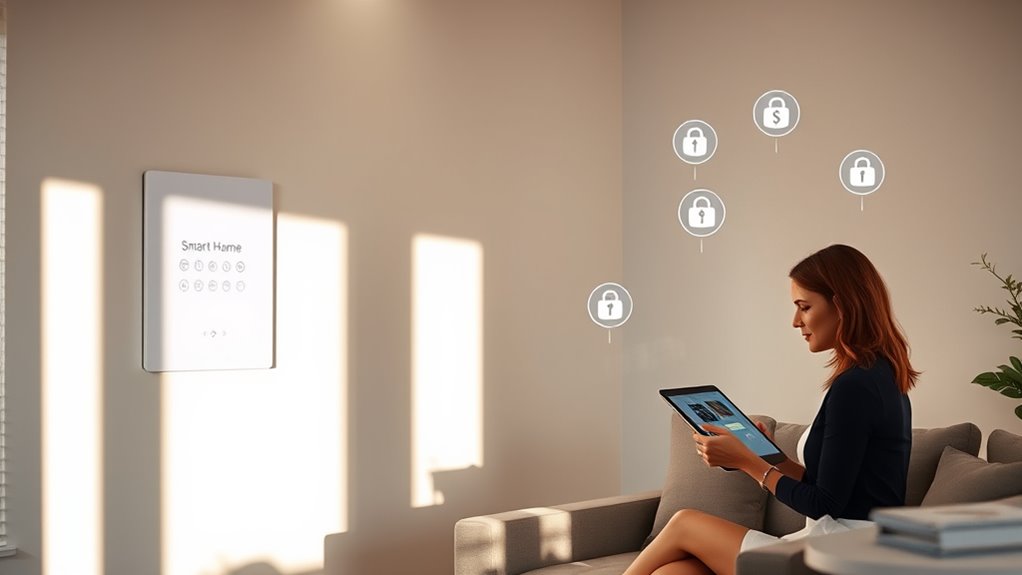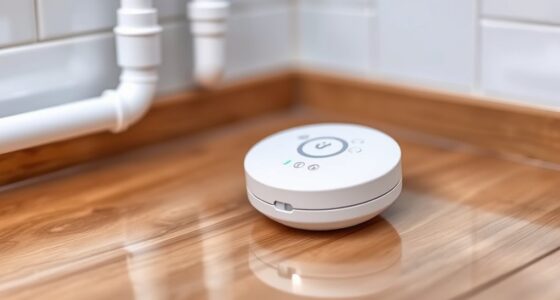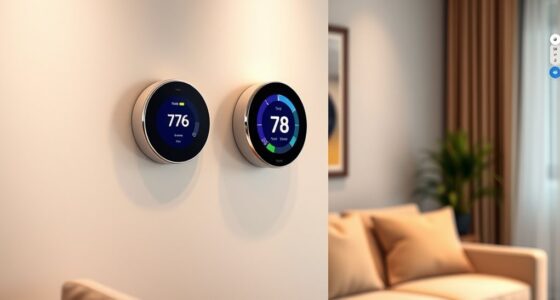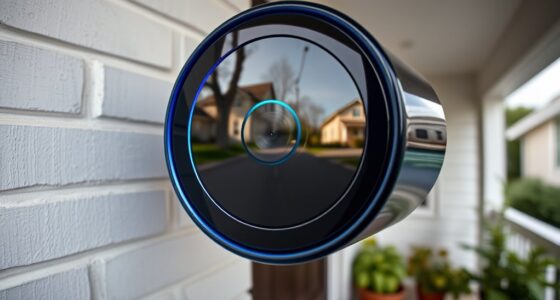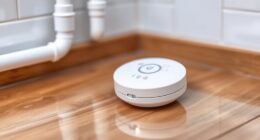To build a privacy-first smart home ecosystem, choose devices with strong end-to-end encryption and reputable manufacturers committed to security. Manage user permissions carefully, only granting access to essential features, and regularly update device firmware. Segment your network for added protection and disable unnecessary permissions. Prioritize informed choices about data collection and storage, and stay vigilant with privacy settings. If you want to learn more about creating a secure, privacy-focused environment, keep exploring the strategies that can protect your personal space.
Key Takeaways
- Select devices that implement end-to-end encryption to protect data during transmission and storage.
- Manage user permissions carefully, granting access only to essential features and disabling unnecessary ones.
- Choose reputable manufacturers committed to privacy by design, with regular updates and transparent security practices.
- Isolate smart devices on separate networks and keep firmware up-to-date to prevent security breaches.
- Regularly review and adjust privacy settings, monitor device activity, and prioritize informed, privacy-conscious choices.
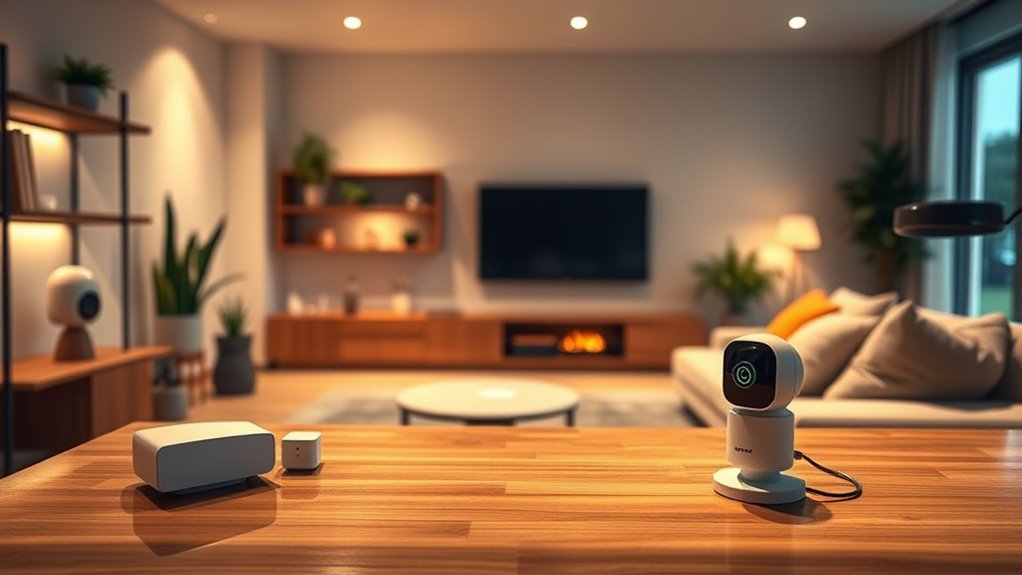
As smart home technology becomes increasingly integrated into daily life, prioritizing privacy is more important than ever. You need to be proactive about how your devices handle your personal information, ensuring that your data stays secure and private. One of the most effective ways to protect your information is by understanding and insisting on data encryption. When your smart devices encrypt data, it transforms your personal information into an unreadable format before it leaves your device or travels across networks. This way, even if someone intercepts your data, they can’t decipher it. Look for devices and services that prioritize end-to-end encryption, which guarantees that your data remains protected from the moment it’s generated until it reaches its destination.
Prioritize devices with end-to-end encryption to keep your smart home data secure and private from start to finish.
Equally critical is giving your informed user consent. When you set up or connect new devices, take the time to review the permissions they request. Many smart home products ask for access to your cameras, microphones, or location data. You should only grant permissions that are absolutely necessary for the device’s core functions. If a device requests more access than it needs, it’s a red flag. User consent isn’t just a formality; it’s a crucial step in maintaining control over your privacy. You should be able to decide what data your devices collect, how it’s used, and who has access to it. Always read privacy policies and settings carefully, and don’t be afraid to disable features or permissions that don’t serve a clear purpose for your smart home needs.
In addition to encryption and user consent, consider the importance of choosing devices from reputable manufacturers who prioritize privacy by design. These companies often incorporate robust security measures, regular updates, and transparent policies into their products. Avoid devices that lack clear privacy controls or that push frequent updates without explaining what they fix or improve. Implementing strong passwords, enabling two-factor authentication where possible, and segmenting your network can further reinforce your privacy efforts. This means creating separate Wi-Fi networks for your smart devices, isolating them from your primary network to prevent potential breaches from spreading.
Furthermore, embracing the concept of creative problem-solving can help you develop innovative ways to secure your smart home ecosystem, especially when facing evolving privacy challenges. Building a privacy-first smart home ecosystem isn’t just about installing the latest gadgets; it’s about actively managing how your data is collected, stored, and shared. By prioritizing data encryption, exercising your right to control your information through user consent, and choosing privacy-conscious products, you can enjoy the benefits of smart technology while safeguarding your personal space. Your privacy depends on these deliberate choices, and taking them empowers you to create a smarter, safer home environment.
Frequently Asked Questions
How Can I Ensure Data Encryption Across All Devices?
To guarantee data encryption across all devices, you should enable end-to-end encryption so your data stays protected from start to finish. Use secure key management practices to control access to encryption keys, preventing unauthorized decryption. Regularly update your device firmware and security settings, and choose devices that support robust encryption standards. These steps help maintain a private, secure smart home environment where your data remains confidential.
What Are the Best Privacy-Focused Smart Home Brands?
They say “you are only as strong as your weakest link,” so choose privacy-focused smart home brands like Apple, Signal, or Hubitat. These brands prioritize data sovereignty and require user consent before sharing info. By selecting devices with robust privacy policies, you protect your data from unauthorized access, ensuring your smart home ecosystem remains secure and private. Always verify each brand’s commitment to transparency and data control.
How to Detect and Prevent Unauthorized Device Access?
To detect and prevent unauthorized device access, you should regularly perform network monitoring to identify unusual activity. Implement strict access controls, such as strong passwords and device authentication, to restrict entry. Keep your firmware updated and disable unnecessary features. Use a secure Wi-Fi network with encryption, and consider segmenting your smart devices onto a separate network. These steps help safeguard your smart home from potential intrusions.
Can I Retrofit Existing Devices for Better Privacy?
Like fitting a new piece into a puzzle, retrofitting existing devices for better privacy can be tricky. You can enhance privacy through firmware updates, adding secure network layers, or using privacy-focused hubs, but device compatibility and retrofit challenges may arise. Some devices lack support for upgrades, making it harder to improve privacy. Stay informed about your device’s capabilities and consider replacing incompatible ones for a truly secure and private smart home.
What Legal Rights Do I Have Regarding My Smart Home Data?
You have legal rights regarding your smart home data, including data ownership and consumer rights. These rights typically mean you control how your data is gathered, used, and shared. Laws like GDPR or CCPA give you the power to access, delete, or restrict your data. You should review your device provider’s privacy policies and exercise your rights to protect your privacy and ensure your data is handled responsibly.
Conclusion
As you build your privacy-first smart home, remember that every device you choose can unexpectedly align to protect your data. It’s a coincidence that small, mindful choices—like secure networks and encrypted devices—can create a fortress of privacy around your home. By staying vigilant and intentional, you’ll find that safeguarding your personal space isn’t just a plan, but a fortunate turn of events. In this way, your smart home becomes both intelligent and truly private.
